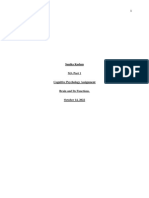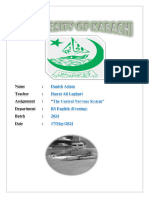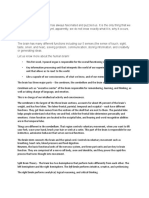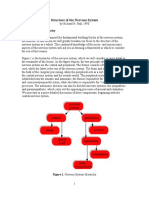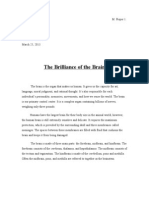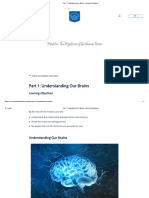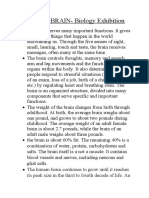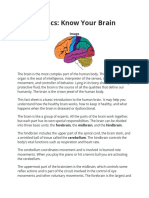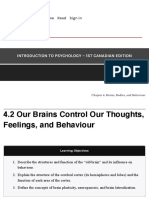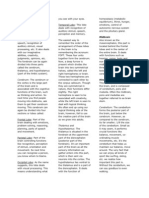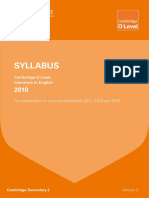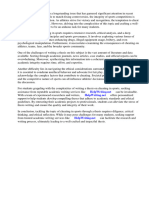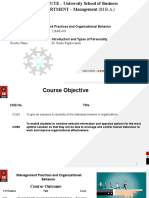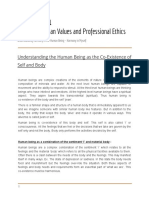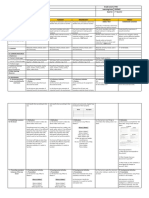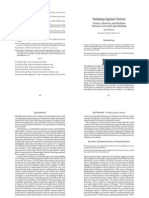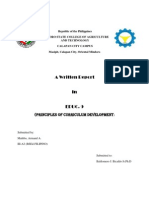Brain and Mind
Brain and Mind
Uploaded by
Mubashir AminOriginal Description:
Copyright
Available Formats
Share this document
Did you find this document useful?
Is this content inappropriate?
Report this DocumentCopyright:
Available Formats
Brain and Mind
Brain and Mind
Uploaded by
Mubashir AminCopyright:
Available Formats
10/1/2014
Psycholinguistics
Brain & Mind
Psycholinguistics | Mubashir Amin
1
Brain -------- What is Brain?
The brain is an organ that serves as the center of the nervous system; everything you are and
everything you do is controlled by your brain. It is located in the head and about 1400 grams of pinkish-
white matter. The brain is the most complex organ of the body. It is composed of nerve cells or neurons
that are the basic information processing units of the nervous system. The human brain contains about
ten billion neurons that are organized into networks of almost unimaginable complexity. It is such an
imperceptible complexity, in which each neuron is linked with thousands of other neurons. It is
believed that each individual neuron network connects with approximately 1,100 other neurons.
Neuroscientists estimate that there are over 12 billion neurons in the brain. It is not only a mass of
interconnected neurons but also a composition based on different structures that are bound to play
specific roles in the integrated functioning of the brain. We can think of the brain as a very large network
of different communication centers that can flash on and off and send messages to one another
through electrical impulses. The brain contains many different specialized information centers
scattered throughout its three-dimensional space. These highly specialized areas of gray matter are
centers or way stations that contain the ability to remember, to formulate decisions, and to issue
commands.
Different areas of gray matter are specialized in different functions, such as moving, seeing, touching,
listening, thinking, or modulating physical functions. These specialized areas of gray matter are
connected to one another through fibers that are like wires; these fiber tracks are the material that we
see in the brain as white matter.
When communication between the centers in the brain breaks down, it may be due either to direct
damage to a center of gray matter or to damage to the wiring between the centers. The brain has an
amazing adaptive capacity that is sometimes referred to as "plasticity" - when damage occurs,
messages can be sent through alternate connections.
As far as the difference between the brain and the mind is concerned, it (the brain) is considered and
treated like a hardware.
Mind -------- What is Mind?
(Will be discussing under the heading of difference between the brain and the mind as well.)
Where there we say that the brain is a hardware, there we also can say that mind is a software.
In order to begin a precise investigation on the topic of the mind, we must first separate from the
traditional thinking that the brain and the mind acts as one.
When one says the term "mind we immediately responds with the idea of the brain. The brain is the
essence to a functional body; the mind however, is the essence of what it means to be human. The
mind can never be pictured; it is an area within one's self where a higher level of contemplation occurs.
The brain however is a visible object. Its function is similar to that of a car engine. It runs the physical
processes of the body, such as movement, or producing the feeling of thirst. When we are thirsty the
brain gets the message and then reacts by telling the body that it needs water. This message arrives
at the brain only through the mind. The brain is not capable of contemplating such ideas as thirst.
Psycholinguistics | Mubashir Amin
2
However, the brain and the mind are in one package. So, where in the brain's hardware is the mind
found? Supposedly it is found in the frontal lobe of the brain. The frontal lobe is involved in paying
attention, planning, behaving emotionally, interacting socially, making decisions and organizing plans.
The relationship between the mind and the brain are one, but different. The brain is the physical part
of the mind and the mind is the neurologically part of the brain. The brain is the portion of the vertebrate
central nervous system that is enclosed within the cranium, continuous with the spinal cord, and
composed of gray matter and white matter. It is primary center for the regulation and control of bodily
activities, receiving and interpreting, sensory impulses, and transmitting information muscles to body
organism.
However, the mind is the human consciousness that originates in the brain and is manifested
especially in thought, emotion, will, memory, and imagination. It is also the faculty of thinking,
reasoning, and applying knowledge. The relationship between the mind and the brain are connected
in every way you perceive it. So without the brain, there would not be such thing called the mind.
Functions of the brain -------- What does the brain do?
(Will be discussed under the heading of the brain structure; and this heading will also cover Hemispheres and their
functions successively.)
The brain is the control center for all the bodys functions, such as walking, talking, swallowing,
breathing, taste, smell, heart rate and so on. It also controls all our thinking functions, our emotions,
how we behave and all our intellectual (cognitive) activities, such as how we attend to things, how we
perceive and understand our world and its physical surroundings, how we learn and remember and
so on.
Damage to a particular part of the brain can produce impairment in the function that it controls. If the
damage is limited to a small area, then it is likely that only a few functions will be impaired. If, however,
as is more common, there is widespread damage, then this can produce a complex array of physical
and psychological problems. The level of impairment will depend on the type, location and severity of
the injury.
There are three main parts that play a vital part in our ability to function:
1. The Cerebral Cortex
2. The Brain Stem
3. The Cerebellum
The Cerebral Cortex
The cerebral cortex is the largest part of the brain and is the area that is responsible for all our thinking
activities. The cortex is a grey wrinkled mass that sits like a cap over the rest of the brain. The wrinkle
appearance results from the cortex being folded in upon itself. It has been estimated that up to 65 per
cent of the cortex is hidden within its folds. It is within the human cortex that the secrets of language
representation and processing are to be found. It is divided into two connected halves the left and
right cerebral hemispheres.
Psycholinguistics | Mubashir Amin
3
The left hemisphere controls the right side of the body and the right hemisphere controls the left.
For example, if a person sustains a brain injury, such as a stroke, to the left hemisphere in the area of
the cerebral cortex that controls movement, this may result in weakness or even paralysis of the right
arm and leg.
In most people, the left hemisphere primarily controls verbal functions such as speech and language
while the right hemisphere primarily controls visual spatial (non-verbal) functions such as those
involved in drawing, rhythm or finding ones way in unfamiliar surroundings. The hemispheres are
known to process material in different ways with the left cerebral hemisphere specializing in processing
material in a sequential and logical manner and the right cerebral hemisphere processing information
in a holistic and intuitive way.
The cerebral cortex is further divided into four areas, or lobes:
1. The Frontal Lobes
2. The Temporal Lobe
3. The Parietal Lobe
4. The Occipital Lobe
Each lobe of the brain controls specific functions and skills.
1. The frontal lobe
The frontal lobe has been termed the executive of the brain. This is where all of our higher-level
thinking goes on. It allows us to:
- Reason logically
- Make decisions
- Plan and organize
- Problem-solve
- Exercise good judgment
- Monitor or manage our actions
It is considered to be the home of our personality and the control center for our emotions and behavior.
The frontal lobes allow us to apply our knowledge and adapt our behavior so that it is appropriate to
the situation we are in. The frontal lobes also contain the motor cortex, a vital part of the brain system
controlling movement.
The frontal lobe is extremely vulnerable to injury due to their position at the front of the skull. Studies
have found that the frontal area is the most common region of injury, even following mild brain injury.
Damage to this area can cause myriad cognitive problems and can dramatically change social
behavior and personality. Physical problems can include the loss of fine movements, lack of strength
in the arms, hands and fingers, little spontaneous facial expression or difficulty in speaking.
2. The temporal lobe
The temporal lobe lies just behind our ears and contains the auditory cortex. This allows us to interpret
sound. The temporal lobe stores most of our memories and is involved in aspects of language,
including our ability to use language and understand what we hear.
Like the frontal lobes, the temporal lobe is involved in regulating certain aspects of personality. Deep
inside the temporal lobe are the structures of the hypothalamus and limbic system. The hypothalamus
is involved in instinctual behaviors such as aggression, sexual arousal, appetite, thirst and temperature
control. The limbic system is in control of emotional reactions.
Psycholinguistics | Mubashir Amin
4
Damage to these areas can severely disrupt our emotions resulting in sudden and dramatic mood
swings; and can also lead to inappropriate social behavior such as hyper-sexuality and impulsiveness.
3. The parietal lobe
The parietal lobe contains the somatosensory cortex which receives and analyses information from
the skin concerning touch, pressure, temperature and some aspects of pain.
The parietal lobe is vital to our spatial understanding of the world. For example, it enables us to
understand where we are in relation to our surroundings and where our body parts are in relation to
each other, as well as the spatial relationships between the things we perceive in our environment.
Damage to the parietal lobe can impair reading, writing and mathematical abilities, drawing and
constructional tasks, as well as self-care abilities such as washing and dressing.
4. The occipital lobe
The occipital lobe analyses what we see and is, therefore, responsible for sight. If it is damaged,
blindness or partial blindness can result.
..
You might also like
- Alan Paskow - The Paradoxes of Art - A Phenomenological Investigation (2004) PDFDocument277 pagesAlan Paskow - The Paradoxes of Art - A Phenomenological Investigation (2004) PDFAurora QuiterioNo ratings yet
- Brain Health - How to Have a Healthy Memory and a Healthy BrainFrom EverandBrain Health - How to Have a Healthy Memory and a Healthy BrainNo ratings yet
- 3B The Brain: Unit Questions: Mia Ramos Block-2Document2 pages3B The Brain: Unit Questions: Mia Ramos Block-2api-296059071No ratings yet
- Perdev Mod 5 Powers of The MindDocument14 pagesPerdev Mod 5 Powers of The MindHanimla OsapmaNo ratings yet
- Cognitive Development ModuleDocument20 pagesCognitive Development ModuleMaria Mendoza AlejandriaNo ratings yet
- Chapter 8 The Mental SelfDocument12 pagesChapter 8 The Mental Selfbulcasejohn21No ratings yet
- The Power To ActDocument38 pagesThe Power To ActRed Lopez100% (1)
- Learning Activity Sheets - Perssonal DevelopmentDocument6 pagesLearning Activity Sheets - Perssonal DevelopmentLyncel FayeNo ratings yet
- PerDev Powers of The Mind Lesson ActivitiesDocument9 pagesPerDev Powers of The Mind Lesson Activitieskath santiagoNo ratings yet
- CognitiveDocument6 pagesCognitivesanika kadamNo ratings yet
- Super Brain: Strategies to Upgrade Your Brain, Unlock Your Potential, Perform at Your Peak, and Achieve AnythingFrom EverandSuper Brain: Strategies to Upgrade Your Brain, Unlock Your Potential, Perform at Your Peak, and Achieve AnythingNo ratings yet
- Personal Development EpDocument3 pagesPersonal Development Epkristine angela baldestamonNo ratings yet
- Dementia and The BrainDocument13 pagesDementia and The BrainLuminita AndreiNo ratings yet
- Mind and Behavior 1Document23 pagesMind and Behavior 1Yara El-GhadbanNo ratings yet
- Hular, Diane S. Physiological Psychology: Reaction Paper On Nervous SystemDocument2 pagesHular, Diane S. Physiological Psychology: Reaction Paper On Nervous SystemViola HastingsNo ratings yet
- CerebrumDocument8 pagesCerebrumBeing AhsanNo ratings yet
- PsychologyDocument8 pagesPsychologyDanish AslamNo ratings yet
- Document 6Document16 pagesDocument 6Vaneeza AliNo ratings yet
- Brain Enhancement. How to Optimize Your Brain for a Fuller Life.From EverandBrain Enhancement. How to Optimize Your Brain for a Fuller Life.No ratings yet
- Brain Structure and FunctionDocument5 pagesBrain Structure and Functionmademoiselle in transitNo ratings yet
- Preparation in Psychology: Bicol University College of Engineering East Campus LegazpiDocument8 pagesPreparation in Psychology: Bicol University College of Engineering East Campus LegazpiKielNo ratings yet
- Introduction To BrainDocument3 pagesIntroduction To BrainrgdevikaNo ratings yet
- Hypnotic Language BootcampDocument200 pagesHypnotic Language BootcampAidil100% (5)
- The Powers of The MindDocument2 pagesThe Powers of The MindErron Francisco NicolNo ratings yet
- Lesson 6 POWERS of The MINDDocument25 pagesLesson 6 POWERS of The MINDRham RhumNo ratings yet
- Brain Structure (Studying 2)Document2 pagesBrain Structure (Studying 2)nnotBlueNo ratings yet
- Brain Parts and FunctionDocument6 pagesBrain Parts and FunctionChabbigillNo ratings yet
- Brain Basics - Know Your Brain - National Institute of Neurological Disorders and StrokeDocument4 pagesBrain Basics - Know Your Brain - National Institute of Neurological Disorders and Strokesurajit halderNo ratings yet
- The BrainDocument28 pagesThe BrainAnania EmmanuelNo ratings yet
- What Comprises A Brain?Document2 pagesWhat Comprises A Brain?NataliaLizcanoNo ratings yet
- Brain Structures and Their Functions PDFDocument26 pagesBrain Structures and Their Functions PDFNur Nashran Mahran100% (4)
- The MindDocument3 pagesThe MindWiam MardianaNo ratings yet
- Science 6 Oct19 22 - Nervous System Part 1Document8 pagesScience 6 Oct19 22 - Nervous System Part 1Pardeep DhillonNo ratings yet
- BrainDocument15 pagesBrainŞterbeţ RuxandraNo ratings yet
- SubjectDocument11 pagesSubjectRoshni GuptaNo ratings yet
- Structure PhysiologyDocument8 pagesStructure PhysiologyfatehahNo ratings yet
- Anfis Sistem NeuroBehaviourDocument37 pagesAnfis Sistem NeuroBehaviourDediSunartoNo ratings yet
- ABPG1103 - Topic 2 - Biological Psychology - 222Document31 pagesABPG1103 - Topic 2 - Biological Psychology - 222nureryani bathowiNo ratings yet
- Chapter 1 ReadingDocument4 pagesChapter 1 ReadingYousef Ahmad2No ratings yet
- The Brilliance of The BrainDocument5 pagesThe Brilliance of The Brainapi-219083677No ratings yet
- Structure of BrainDocument24 pagesStructure of Brainhajiwaheed0604No ratings yet
- NeuropsychologyDocument28 pagesNeuropsychologyFarhan AkhtarNo ratings yet
- Part 1 - Understanding Our Brains - Centre of ExcellenceDocument7 pagesPart 1 - Understanding Our Brains - Centre of ExcellencedanielaamazonNo ratings yet
- Week 2 - HSO207Document23 pagesWeek 2 - HSO207eliza.tolfreyNo ratings yet
- The BrainDocument12 pagesThe BrainSaadNo ratings yet
- Brain & BehaviourDocument11 pagesBrain & Behaviourtekhminafareed12No ratings yet
- The Human BrainDocument6 pagesThe Human BraindamanzurNo ratings yet
- โท the BrainDocument39 pagesโท the BrainFadil Wanna-mart100% (1)
- Human BrainDocument13 pagesHuman BrainAaniya AsadNo ratings yet
- Neuroscience in The Workplace How Understanding The Brain Can Transform Your Business e BookDocument34 pagesNeuroscience in The Workplace How Understanding The Brain Can Transform Your Business e BookHarish C NNo ratings yet
- 1 BrainDocument2 pages1 BrainJonance YeeNo ratings yet
- 4.2 Our Brains Control Our Thoughts, Feelings, and BehaviourDocument18 pages4.2 Our Brains Control Our Thoughts, Feelings, and BehaviouradelaNo ratings yet
- 1.7 What Does The Brain DoDocument3 pages1.7 What Does The Brain DoStella StaryNo ratings yet
- Personal Development Week 7-8Document10 pagesPersonal Development Week 7-8Edilene Rosallosa CruzatNo ratings yet
- Fore BrainDocument3 pagesFore BrainAngela EndayaNo ratings yet
- 2-Learning To Live in Cheon Il Guk - Lesssons Fron Brain ResearchDocument19 pages2-Learning To Live in Cheon Il Guk - Lesssons Fron Brain ResearchFirmino de Oliveira FialhoNo ratings yet
- Module 3 - Facilitating Learner - Centered TeachingDocument6 pagesModule 3 - Facilitating Learner - Centered TeachingSheila Mae Paltep100% (1)
- Brain System: Parts and FunctionsDocument9 pagesBrain System: Parts and FunctionsChristhoper John Dela CruzNo ratings yet
- PsychologyDocument6 pagesPsychologymahbinaalone7No ratings yet
- O-Level English LiteratureDocument20 pagesO-Level English LiteratureMubashir Amin100% (1)
- Ancient PhilosophyDocument145 pagesAncient PhilosophyMubashir AminNo ratings yet
- Influence of Islam On Indian CultureDocument759 pagesInfluence of Islam On Indian CultureMubashir AminNo ratings yet
- Instructional Technology vs. Educational Technology: by K. HallDocument8 pagesInstructional Technology vs. Educational Technology: by K. HallMubashir AminNo ratings yet
- Curriculum, History and TypesDocument14 pagesCurriculum, History and TypesMubashir AminNo ratings yet
- List of The Books On GraphologyDocument9 pagesList of The Books On GraphologyMubashir AminNo ratings yet
- Pragmatic Approach and The Choice of MethodsDocument18 pagesPragmatic Approach and The Choice of MethodsMubashir AminNo ratings yet
- Cheating in Sports Thesis StatementDocument6 pagesCheating in Sports Thesis Statementdanielledaviskansascity100% (2)
- Our Most Curious Device: The Instrument of ChoiceDocument14 pagesOur Most Curious Device: The Instrument of ChoiceMiguel GarcíaNo ratings yet
- 20b - ΑΓΧΟΣ ΚΑΙ ΜΥΣΤΙΚΟΙ ΚΩΔΙΚΕΣ ΑΣΚΛΗΠΙΟΥ - EGDocument178 pages20b - ΑΓΧΟΣ ΚΑΙ ΜΥΣΤΙΚΟΙ ΚΩΔΙΚΕΣ ΑΣΚΛΗΠΙΟΥ - EGO TΣΑΡΟΣ ΤΗΣ ΑΝΤΙΒΑΡΥΤΗΤΑΣ ΛΙΑΠΗΣ ΠΑΝΑΓΙΩΤΗΣNo ratings yet
- Local Media5165355875185176994Document174 pagesLocal Media5165355875185176994Katrine ManaoNo ratings yet
- PHYSICS SyllabusDocument62 pagesPHYSICS SyllabusNoah OkitoiNo ratings yet
- From Swift To Swiss Tactical Decision Games and Their Place in Military Education and Performance ImprovementDocument10 pagesFrom Swift To Swiss Tactical Decision Games and Their Place in Military Education and Performance Improvementkako083No ratings yet
- 1-1 Intj PersonalityDocument17 pages1-1 Intj PersonalitynestemanNo ratings yet
- (Mark Letteri) Heidegger and The Question of PsychologyDocument126 pages(Mark Letteri) Heidegger and The Question of PsychologyMarcelo Vial RoeheNo ratings yet
- Introduction and Types of PersonalityDocument17 pagesIntroduction and Types of PersonalityVikash kumarNo ratings yet
- WUC 203 Unit 5Document170 pagesWUC 203 Unit 5Foo Chuat MengNo ratings yet
- Manage Your Career: 10 Keys To Survival and Success When Interviewing and On The JobDocument27 pagesManage Your Career: 10 Keys To Survival and Success When Interviewing and On The JobBusiness Expert PressNo ratings yet
- Critical AnalysisDocument7 pagesCritical AnalysisNabi Box100% (1)
- The Genius MethodDocument91 pagesThe Genius MethodIsrael100% (2)
- KVE-401-Universal Human Values & Professional Ethics PDFDocument16 pagesKVE-401-Universal Human Values & Professional Ethics PDFNeha Pal75% (4)
- Science-Dll-Week-6-Quarter 1Document7 pagesScience-Dll-Week-6-Quarter 1Ma. Joan Mae MagnoNo ratings yet
- AIGA - Course Catalog-V2Document15 pagesAIGA - Course Catalog-V2simgederdiyokNo ratings yet
- David Kleinberg-Levin - Beckett's Words - The Promise of Happiness in A Time of Mourning-Bloomsbury Academic (2015)Document329 pagesDavid Kleinberg-Levin - Beckett's Words - The Promise of Happiness in A Time of Mourning-Bloomsbury Academic (2015)Mina NJNo ratings yet
- Negative Self-Talk and How To Change It (Shad Helmstetter)Document60 pagesNegative Self-Talk and How To Change It (Shad Helmstetter)King George100% (1)
- Thinking Against NatureDocument10 pagesThinking Against NatureFredrik MarkgrenNo ratings yet
- Introduction To Strategic Management: Topic OutlineDocument7 pagesIntroduction To Strategic Management: Topic OutlineJoyce DuaNo ratings yet
- Intuition in Mathematics PDFDocument31 pagesIntuition in Mathematics PDFhungbkpro90No ratings yet
- School Quality Assessment and Assurance Framework: Central Board of Secondary EducationDocument300 pagesSchool Quality Assessment and Assurance Framework: Central Board of Secondary EducationPolice DAV Public SchoolNo ratings yet
- Ship Engineer FMTDocument16 pagesShip Engineer FMThope701585No ratings yet
- UHV (MCQ'S)Document34 pagesUHV (MCQ'S)Gowthamguptha GowthamNo ratings yet
- BUSINESS RESEARCH METHODS - Unit GuideDocument9 pagesBUSINESS RESEARCH METHODS - Unit GuidePhat Nguyen ThanhNo ratings yet
- Plato and Freud: The Psychoanalytic QuarterlyDocument33 pagesPlato and Freud: The Psychoanalytic QuarterlySotiris KNo ratings yet
- The Power To VisualizeDocument34 pagesThe Power To VisualizenoorNo ratings yet
- Artificial Aesthetics - Chapter 1Document26 pagesArtificial Aesthetics - Chapter 1Anna Giralt GrisNo ratings yet
- Report in Curriculum DevelopmentDocument13 pagesReport in Curriculum DevelopmentArmand A. MañiboNo ratings yet










